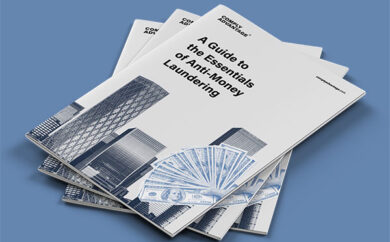

The European Union deploys sanctions against targets around the world as part of its Common Foreign and Security Policy (CFSP). While sanctions are imposed in order to protect the EU’s security interests, or to address violations of treaty agreements and international law, the EU also implements sanctions as a way to punish human rights abuses. Recently, the EU developed and adopted a new Global Human Rights Sanctions Regime (GHRSR) that expands its powers to target individual perpetrators of human rights abuses.
In order to ensure compliance with EU regulations, and to avoid facilitating human rights crimes around the world, financial institutions in the EU must understand the new sanctions landscape and how the introduction of the EU Human Rights Sanctions Regime will affect their sanctions screening responsibilities.

What is the EU human rights sanctions regime?
The EU has penalized numerous human rights abuses around the world as part of its existing sanctions regime, with examples including actions against China for the Tiananmen Square Massacre, and against Iran for the torture of human rights activists. The EU implements economic sanctions in response to the conduct of other countries, organizations, and individuals, and does so in line with the principles of the CFSP. In addition to punishing human rights abuses, EU sanctions are adopted in order to:
- Protect EU values, interests, and security
- Preserve international peace
- Support democracy and the rule of law
- Avoid conflicts and preserve international security
EU human rights policy is based on the principles of both protecting and promoting fundamental human rights. The EU puts human rights ‘at the heart’ of its relationships with other countries and works in partnership with other countries and international organizations to achieve a number of specific human rights objectives including:
- The promotion of rights for women, children, minorities, and refugees
- Opposition to the death penalty and torture
- Opposition to human trafficking
- Opposition to discrimination
- The inclusion of human rights clauses in international agreements
The EU human rights sanctions regime issues sanctions from the European Council: members of council must agree unanimously to impose sanctions before the relevant legislation is drafted and enforced. Human rights sanctions that are issued by the EU may involve the following measures:
- Asset freezes
- Arms embargoes
- Travel bans
- Trade, investment, and travel restrictions
When implementing sanctions as a consequence of human rights abuses (or for other reasons), the EU seeks to minimize adverse consequences for civilian populations.
Penalties: Violations of the EU human rights sanctions regime are serious criminal offences and may result in financial penalties and prison sentences. Individual EU member states may determine the severity of the penalties they impose for sanctions violations but must ensure they are sufficient to deter future transgressions. In February 2020, for example, the Netherlands imposed a fine of over €4.5 million on Euroturbine for violating an EU export ban on Iran, while in March 2020 the UK imposed a £20.5 million fine on Standard Chartered Bank for a series of loans that violated EU sanctions.
What is the Global Human Rights Sanctions Regime?
Following its proposal in 2018, the EU’s Global Human Rights Sanctions Regime came into effect on 7 December 2020. Rather than targeting entire countries or governments, the GHRSR is a framework that enables the EU to impose targeted sanctions ‘in a more tangible and direct way’ against individuals and entities that commit human rights abuses in foreign countries.The regime is intended to be used against serious human rights abuses and covers – but is not limited to – crimes such as:
- Genocide
- Torture
- Slavery
- Cruel, inhuman, or degrading punishment
- Extrajudicial, summary, or arbitrary killings
- Gender-based violence
- Human trafficking
- Abuses of freedom of assembly and expression
- Abuses of freedom of religious belief
- Arbitrary detentions and arrests
- Enforced disappearances
The GHRSR reflects ‘Magnitsky Act’ sanctions measures introduced in the United States in 2012 as a response to the inhumane treatment and death of Russian lawyer Sergei Magnitsky in 2009. Similar targeted sanctions regimes have also been introduced in Canada with the Justice for Victims of Corrupt Foreign Officials Act, and in the UK with the Global Human Rights Sanction Regulations. Like the Magnitsky sanctions, the GHRSR is intended to help the EU respond to violence against journalists, political figures, and media figures that is motivated by ideology or religion.
Individuals and entities that are targeted by the Global Human Rights Sanctions Regime may be subject to the following measures and restrictions:
- Asset freezes
- Prohibitions on access to funds and economic resources within the EU
- Prohibitions on entry to the EU
Recent EU human rights sanctions
Examples of enforcement of the EU human rights sanctions regime include recent actions taken against Russia and Belarus.
EU sanctions against Belarus have been in place since October 2020 and are implemented under the EU’s sanctions regime rather than the GHRSR. The sanctions relate to the violent repression of pro-democracy protests, along with opposition political figures and journalists, by the ruling political regime led by President Aleksandr Lukashenko. Imposing travel bans, asset freezes, and a prohibition on access to EU funds, the sanctions designate 88 Belarusian officials and 7 entities. In February 2021, the EU Council voted to extend sanctions against Belarus until 28 February 2022.
While the EU already imposes sanctions on Russia for threatening the sovereignty and independence of Ukraine, in 2021 the European Council made new designations under the GHRSR in response to the poisoning and imprisonment of political leader, Alexei Navalny. GHRSR sanctions measures imposed by the EU targeted Russia’s investigative committee leader, Alexander Bastrykin, prosecutor-general, Igor Krasnov, head of the Russian national guard, Viktor Zolotov, and the head of Russia’s federal prisons, Alexander Kalashnikov.
EU human rights sanctions screening compliance
In order to comply with the EU human rights sanctions regime and to prevent human rights abuses, financial institutions must be able to accurately screen customers against the EU sanctions list.
Effective sanctions screening solutions should be updated with the latest designations and account for a range of sanctions challenges, including non-Western naming conventions, the use of non-Latinate characters in spellings, and the use of aliases.
Firms should build their sanctions screening measures on a robust Know Your Customer (KYC) process, establishing and verifying the identities of customers at onboarding with suitable due diligence measures. Similarly, firms should monitor customer transactions to ensure they do not involve sanctioned persons and screen on an ongoing basis for adverse media that involves their customers.
Smart compliance: In order to manage the vast amounts of data required by EU sanctions compliance, firms should seek to integrate smart technology tools. In addition to providing automated speed and efficiency for the sanctions screening process, smart technology tools also allow firms to adjust quickly as names are added and withdrawn from the EU sanctions list, and to adapt to changes to sanctions regulation, such as the introduction of the GHRSR.
Sanctions Screening Tool
>Discover how our Global Sanctions & Watchlists Screening Software can keep your organization protected.
Request a DemoOriginally published 07 May 2021, updated 27 August 2024
Disclaimer: This is for general information only. The information presented does not constitute legal advice. ComplyAdvantage accepts no responsibility for any information contained herein and disclaims and excludes any liability in respect of the contents or for action taken based on this information.
Copyright © 2025 IVXS UK Limited (trading as ComplyAdvantage).
